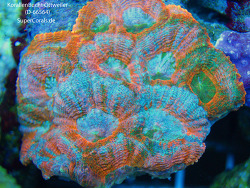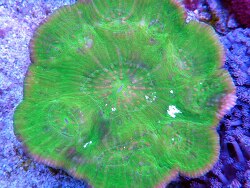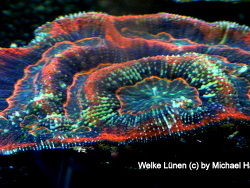Info
Veron, 1985
Although Lobophyllia rowleyensis can be found in Germany from time to time, they are rather rare.
They are real beauties with their coloration.
In the past, they were usually sent out under the name Scolymia vitiensis and also referred to as such.
When keeping them, it is really important not to place them in too bright a light.
If you place them upwards, under a strong light source, you won't have much fun with them.
They should therefore be kept on the ground or in the shade.
Apart from that, they are very grateful pets in the reef aquarium, which reward good environmental conditions with great colors.
In the USA, prices of 300 to 500 dollars per animal are sometimes paid, depending on size and coloration.
It is the only species of the genus.
Characters: Colonies are flattened, helmet- or dome-shaped. Corallites are subcerioid or have short, shallow valleys 8-20 millimetres wide, separated by thick walls. Tissue over the septa is usually distinct in colour and/or texture from tissue over the costae. Septa and costae are sturdy, with large blunt teeth.
Synonyms:
Australomussa rowleyensis Veron, 1985 · unaccepted > superseded combination (basionym)
Parascolymia rowleyensis (Veron, 1985) · unaccepted > superseded combination
Although Lobophyllia rowleyensis can be found in Germany from time to time, they are rather rare.
They are real beauties with their coloration.
In the past, they were usually sent out under the name Scolymia vitiensis and also referred to as such.
When keeping them, it is really important not to place them in too bright a light.
If you place them upwards, under a strong light source, you won't have much fun with them.
They should therefore be kept on the ground or in the shade.
Apart from that, they are very grateful pets in the reef aquarium, which reward good environmental conditions with great colors.
In the USA, prices of 300 to 500 dollars per animal are sometimes paid, depending on size and coloration.
It is the only species of the genus.
Characters: Colonies are flattened, helmet- or dome-shaped. Corallites are subcerioid or have short, shallow valleys 8-20 millimetres wide, separated by thick walls. Tissue over the septa is usually distinct in colour and/or texture from tissue over the costae. Septa and costae are sturdy, with large blunt teeth.
Synonyms:
Australomussa rowleyensis Veron, 1985 · unaccepted > superseded combination (basionym)
Parascolymia rowleyensis (Veron, 1985) · unaccepted > superseded combination







 robertbaur
robertbaur




























